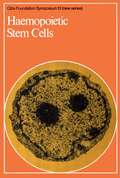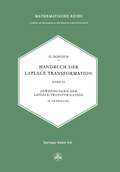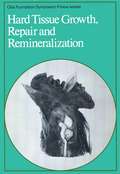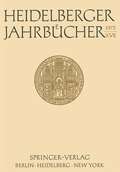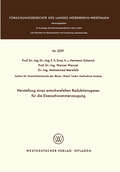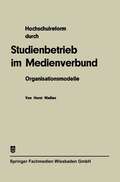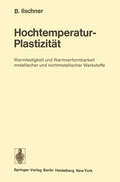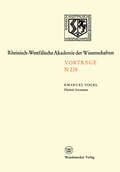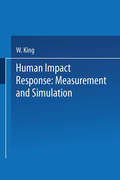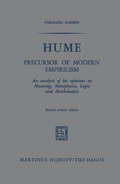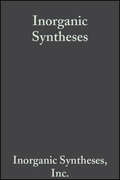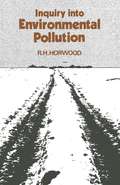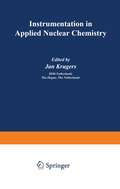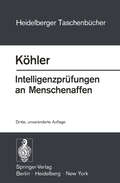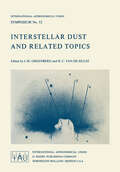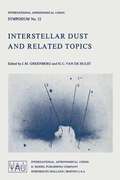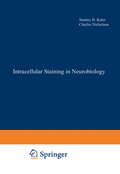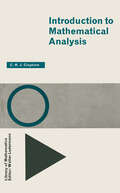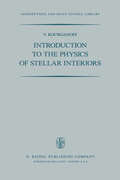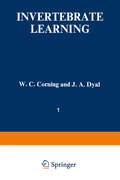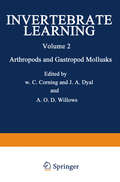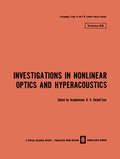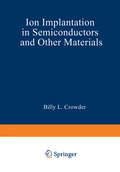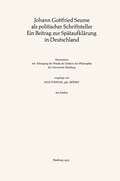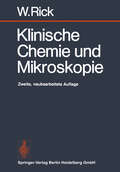- Table View
- List View
Haemopoietic Stem Cells (Novartis Foundation Symposia #13)
by G. E. W. Wolstenholme Maeve O'ConnorThe Novartis Foundation Series is a popular collection of the proceedings from Novartis Foundation Symposia, in which groups of leading scientists from a range of topics across biology, chemistry and medicine assembled to present papers and discuss results. The Novartis Foundation, originally known as the Ciba Foundation, is well known to scientists and clinicians around the world.
Handbuch der Laplace-Transformation: Band 3: Anwendungen der Laplace-Transformation (Lehrbücher und Monographien aus dem Gebiete der exakten Wissenschaften #19)
by G. DoetschDer vorliegende Band III bildet mit dem früher erschienenen Band II ein Ganzes, was auch äusserlich dadurch zum Ausdruck kommt, dass die Teile und Kapitel anschliessend an die von Band II weiternumeriert sind. Gegenüber der früheren Darstellung in meiner Monographie ~Theorie und Anwendung der Laplace-Transformation» von 1937 hat sich auch in diesem. Band der Stoff auf allen Gebieten stark ausgeweitet. Manches ist ausführlicher dargestellt, anderes ganz neu hinzugekommen, wie die Kapitel über partielle Differentialgleichungen mit variablen Koeffizienten, Kompatibilitätsbedingungen für Randwertprobleme, Differenzengleichungen, Integralgleichungen im unendlichen Intervall, verschie dene mit Laplace-Transformation lösbare Integralgleichungen und ganze Funk tionen vom Exponentialtypus. Letztere bieten ein schier unerschöpfliches Feld für Anwendungen der Laplace-Transformation, und die dargestellten Unter suchungen möchten zu weiteren Forschungen auf diesem Gebiet anregen. Bei den Funktionalgleichungen sei besonders auf die Differenzengleichungen verwiesen, deren Behandlung mit Laplace-Transformation hier zum erstellmal in Buchform vollständig dargestellt ist. An Hand der Theorie der Kettenleiter, der Schrittregler und ähnlicher Probleme ist in letzter Zeit in der Technik ein neu es Interesse an den Differenzengleichungen erwacht, und für die hier vorliegenden Fragen dürfte insbesondere das 22. Kapitel brauchbare Methoden liefern.
Hard Tissue Growth, Repair and Remineralization (Novartis Foundation Symposia #11)
by Katherine Elliott David W. FitzSimonsThe Novartis Foundation Series is a popular collection of the proceedings from Novartis Foundation Symposia, in which groups of leading scientists from a range of topics across biology, chemistry and medicine assembled to present papers and discuss results. The Novartis Foundation, originally known as the Ciba Foundation, is well known to scientists and clinicians around the world.
Heidelberger Jahrbücher XVII (Heidelberger Jahrbücher #17)
by Hans Walter Wolff Günter Menges Jacob Marschak Hellmut Salowsky Bert Nagel Hans-Ulrich Kolb Joachim Telle Rolf Binner Erika Kollnig-Schattschneider Hermann Glockner Walter Henss Hans SchaeferHerstellung eines entschwefelten Reduktionsgases für die Eisenschwammerzeugung (Forschungsberichte des Landes Nordrhein-Westfalen #2297)
by Hermann SchenckHochtemperatur-Plastizität: Warmfestigkeit und Warmverformbarkeit metallischer und nichtmetallischer Werkstoffe (Reine und angewandte Metallkunde in Einzeldarstellungen #23)
by Bernhard IlschnerHückel-Aromaten: 187. Sitzung am 4. März 1970 in Düsseldorf (Rheinisch-Westfälische Akademie der Wissenschaften #228)
by Emanuel VogelHume: Precursor of Modern Empiricism
by Farhang ZabeehDavid Hume is the most influential precursor of modern empiri cism. By modern empiricism, I intend a belief that all cognitive conflicts can be resolved, in principle, by either appeal to matters off act, via scientific procedure, or by appeal to some sets of natural or conventional standards, whether linguistic, mathematical, aes thetic or political. This belief itself is a consequent of an old appre hension that all synthetic knowledge is based on experience, and that the rest can be reduced to a set of self-evident truths. In this broad sense, Modern Empiricism encompasses classes, such as Logi cal Empiricism, Logical Atomism and Philosophical Analysis, and unique individuals such as Russell and Moore. It excludes, thereby, the present day continental philosophies, such as Thomism, Exist entialism, and Dialectical Materialism. Modem empiricists, to be sure, are influenced by many other phi losophers. Locke, Berkeley, and Mill, among the classical empiri cists, and Leibniz and Kant, among the rationalists (the former especially on the logico-mathematical side) in one way or other are responsible for the appearance of empiricism in its new form. But none of them were as influential as Hume. This, by itself is not news. Weinberg, in his well-known book, An Examination of Logical Positivism, observes that: Many, if not all, of the principal doctrines of contemporary positivism derive from Hume.
Inorganic Syntheses (Inorganic Syntheses #14)
by Aaron Wold John K. RuffThe volumes in this continuing series provide a compilation of current techniques and ideas in inorganic synthetic chemistry. Includes inorganic polymer syntheses and preparation of important inorganic solids, syntheses used in the development of pharmacologically active inorganic compounds, small-molecule coordination complexes, and related compounds. Also contains valuable information on transition organometallic compounds including species with metal-metal cluster molecules. All syntheses presented here have been tested.
Instrumentation in Applied Nuclear Chemistry
by Jan KrugersThis book attempts to build a bridge between two sciences: chemistry and electronics. The inside of the black boxes the nuclear chemist uses daily is explained in simple electronic terms. Knowledge of the inside not only satisfies curiosity but helps one "get the most out of the available equipment." Likewise, this book tries to give sufficient understanding for not "over buying," that is to say, for buying the equipment which just serves the purpose, instead of buying the best so at least it will serve the purpose. The first three chapters give a concise understanding of what the area of applied nuclear chemistry is concerned with and what kind of equipment is generally used. Chapter 1 gives a theoretical background, while Chapter 3 deals with the practical implementations. Thus, these chapters provide the background to determine what one can expect from the experiments. The remainder of the book is devoted to the practical instrumentation of the experiments. Each chapter deals with specific types of instruments and devices, discusses briefly the electronics involved, considers the limitations, and investigates how and to what extent they can be circumvented. The advantage of having different contributors, each with his own practical experience, shows clearly in this latter aspect. Detailed practical knowledge and experience can be explained best by the person who has long been con cerned with the subject theoretically and practically.
Intelligenzprüfungen an Menschenaffen: Mit einem Anhang zur Psychologie des Schimpansen (Heidelberger Taschenbücher #134)
by W. KöhlerInterstellar Dust and Related Topics (International Astronomical Union Symposia #52)
by J. Mayo Greenberg H. C. HulstIAU Symposium Number 52 on Interstellar Dust and Related Topics was held at Albany, N.Y., on the campus of the State University of New York at Albany from May 29 to June 2, 1972. The members of the Organizing Committee were: Dr A. D. Code, University of Wisconsin, Madison, Wis., U.S.A. Dr B. D. Donn, Goddard Space Flight Center, Greenbelt, Md., U.S.A. Dr A. Elvius, Stockholm Observatory, Saltsjobaden, Sweden. Dr T. Gehrels, Lunar and Planetary Laboratory, University of Arizona, Tucson, Ariz., U.S.A. Dr J. M. Greenberg (Chairman), State University of New York at Albany, Albany, N.Y., U.S.A. Dr H. C. van de Hulst, Sterrewacht, Leiden, Holland. Dr S. B. Pikel'ner, Sternberg Astronomical Institute, Moscow, U.S.S.R. Dr E. E. Salpeter, Cornell University, Ithaca, N.Y., U.S.A. Dr B. E. Turner, National Radio Astronomy Observatory, Charlottesville, Va., U.S.A. The suggestion was first made in 1971 that a symposium on interstellar grains would be timely. The response to the first preliminary announcement, which was sent out on November 29, 1971, was well beyond our expectations. The meeting was locally sponsored by the State University and by Dudley Observatory. The National Aeronautics and Space Administration and the National Science Foundation con tributed along with the IAU. There were 158 participants of whom 49 were from 15 countries outside the United States. A total of 92 papers were presented.
Interstellar Dust and Related Topics (International Astronomical Union Symposia #52)
by J. Mayo Greenberg H. C. Van De HulstIAU Symposium Number 52 on Interstellar Dust and Related Topics was held at Albany, N.Y., on the campus of the State University of New York at Albany from May 29 to June 2, 1972. The members of the Organizing Committee were: Dr A. D. Code, University of Wisconsin, Madison, Wis., U.S.A. Dr B. D. Donn, Goddard Space Flight Center, Greenbelt, Md., U.S.A. Dr A. Elvius, Stockholm Observatory, Saltsjobaden, Sweden. Dr T. Gehrels, Lunar and Planetary Laboratory, University of Arizona, Tucson, Ariz., U.S.A. Dr J. M. Greenberg (Chairman), State University of New York at Albany, Albany, N.Y., U.S.A. Dr H. C. van de Hulst, Sterrewacht, Leiden, Holland. Dr S. B. Pikel'ner, Sternberg Astronomical Institute, Moscow, U.S.S.R. Dr E. E. Sal peter, Cornell University, Ithaca, N.Y., U.S.A. Dr B. E. Turner, National Radio Astronomy Observatory, Charlottesville, Va., U.S.A. The suggestion was first made in 1971 that a symposium on interstellar grains would be timely. The response to the first preliminary announcement, which was sent out on November 29, 1971, was well beyond our expectations. The meeting was locally sponsored by the State University and by Dudley Observatory. The National Aeronautics and Space Administration and the National Science Foundation con tributed along with the JAU. There were 158 participants of whom 49 were from 15 countries outside the United States. A total of 92 papers were presented.
Intracellular Staining in Neurobiology
by Stanley B. Kater Charles NicholsonThe purpose of this book is to provide basic reference material to facilitate the further development and application of the intracellular staining techniques which originated with the introduction of Procion dye as a neurocellular stain. We had sev eral specific objectives in compiling these chapters. First, we recognized that both the techniques and results of intracellular staining have been derived from a variety of preparations and published in diverse journals. Consequently, we tried to make this information more readily available by incorporating several reviews by original authors. This should provide the reader with a knowledge of the kinds of neurobiological prob lems for which intracellular staining has already been employed. A second objective was to facilitate extension of these methods to a wider variety of problems. To this end there are chapters dealing with Procion dye as a marker for ultrastructural investi gations, the use of cobalt as a staining compound and the implementation of computer techniques for quantitative studies of neuronal relationships. As background for further extension of these methods this volume contains material on the history of the discovery of Procion dyes as intracellular stains, the chemistry of these dyes, and fundamentals of fluorescence microscopy. Our final specific objective was to present details of technical procedures that were not readily available in the literature.
Introduction to Mathematical Analysis (Library of Mathematics)
by C. ClaphamI have tried to provide an introduction, at an elementary level, to some of the important topics in real analysis, without avoiding reference to the central role which the completeness of the real numbers plays throughout. Many elementary textbooks are written on the assumption that an appeal to the complete ness axiom is beyond their scope; my aim here has been to give an account of the development from axiomatic beginnings, without gaps, while keeping the treatment reasonably simple. Little previous knowledge is assumed, though it is likely that any reader will have had some experience of calculus. I hope that the book will give the non-specialist, who may have considerable facility in techniques, an appreciation of the foundations and rigorous framework of the mathematics that he uses in its applications; while, for the intending mathe matician, it will be more of a beginner's book in preparation for more advanced study of analysis. I should finally like to record my thanks to Professor Ledermann for the suggestions and comments that he made after reading the first draft of the text.
Introduction to the Physics of Stellar Interiors (Astrophysics and Space Science Library #34)
by V. KourganoffAll astrophysicists are acquainted with the fundamental works ofS. Chandrasekhar [6] and M. Schwarzschild [1] concerning the internal structure of stars. Although both of these works accentuate the principal mathematical devices of the theory (and use, for this reason, notations that are rather perplexing for the non-specialist), the work of Schwarzschild is distinguished by care in demonstrating the physical meaning of the principal equations, while that of Chandrasekhar makes every effort not to skip a single step in the calculations. On the other hand, Schwarz schild , who considers his two introductory chapters as simple reviews of results which are already known, passes a bit rapidly over certain difficult arguments, and Chandrasekhar never goes far enough in the analysis of the physical mechanisms involved. From another point of view, the excellent review articles published in the Ency clopedia of Physics [5] by M. H. Wrubel, P. Ledoux, and others, and those published in Stars and Stellar Systems [4] by H. Reeves, B. Stromgren, R. L. Sears and R. R. Brownlee, and others, are principally intended for research workers who are already initiated into the theory of internal structure. These monographs are on a level that is clearly too high for the general physicist who is approaching these astrophysical questions for the first time, and more particularly for the post-graduate student.
Invertebrate Learning: Volume 1 Protozoans Through Annelids
by William CorningSince the publication of the second volume of Comparative Psychology by Warden, Warner, and Jenkins (1940), there has not been a comprehensive review of invertebrate learning capacities. Some high-quality reviews have appeared in various journals, texts, and symposia, but they have been, of necessity, incomplete and selective either in terms of the phyla covered or the phenomena which were reviewed. Although this lack has served as a stimulus for the present series, the primary justification is to be found in the resurgence of theoretical and empirical interests in learning capacities and mechanisms in simpler systems of widely different phylogenetic origin. Intensive research on the physiological basis of learning and memory clearly entails exploration of the correlations between levels of nervous system organization and be havioral plasticity. Furthermore, the presence of structural-functional differ entiation in ganglionated systems, the existence of giant, easily identifiable cells, and the reduced complexity of structure and behavior repertoires are among the advantages of the "simple systems" strategy which have caused many neuroscientists to abandon their cats, rats, and monkeys in favor of mollusks, leeches, planaria, crayfish, protozoa, and other invertebrate preparations. Behavioral research continues to reveal remarkable capacities in these simple organisms and encourages us to believe that the confluence of the invertebrate learning data with the more voluminous vertebrate litera ture will contribute substantially to the enrichment of all of the neurobe havioral sciences.
Investigations in Nonlinear Optics and Hyperacoustics (The Lebedev Physics Institute Series #58)
by D. V. Skobel’tsynIon Implantation in Semiconductors and Other Materials (The IBM Research Symposia Series)
by Billy CrowderDuring the years since the first conference in this series was held at Thousand Oaks, California, in 1970, ion implantation has been an expanding and exciting research area. The advances in this field were so rapid that a second conference convened at Garmisch Partenkirchen, Germany, in 1971. At the present time, our under standing of the ion implantation process in semiconductors such as Si and Ge has reached a stage of maturity and ion implantation techniques are firmly established in semiconductor device technology. The advances in compound semiconductors have not been as rapid. There has also been a shift in emphasis in ion implanta tion research from semiconductors to other materials such as metals and insulators. It was appropriate to increase the scope of the conference and the IIIrd International Conference on Ion Implanta tion in Semiconductors and Other Materials was held at Yorktown Heights, New York, December 11 to 14, 1972. A significant number of the papers presented at this conference dealt with ion implanta tion in metals, insulators, and compound semiconductors. The International Committee responsible for organizing this conference consisted of B. L. Crowder, J. A. Davies, F. H. Eisen, Ph. Glotin, T. Itoh, A. U. MacRae, J. W. Mayer, G. Dearnaley, and I. Ruge. The Conference attracted 180 participants from twelve countries. The success of the Conference was due in large measure to the financial support of our sponsors, Air Force Cambridge Research Laboratories and the Office of Naval Research.
